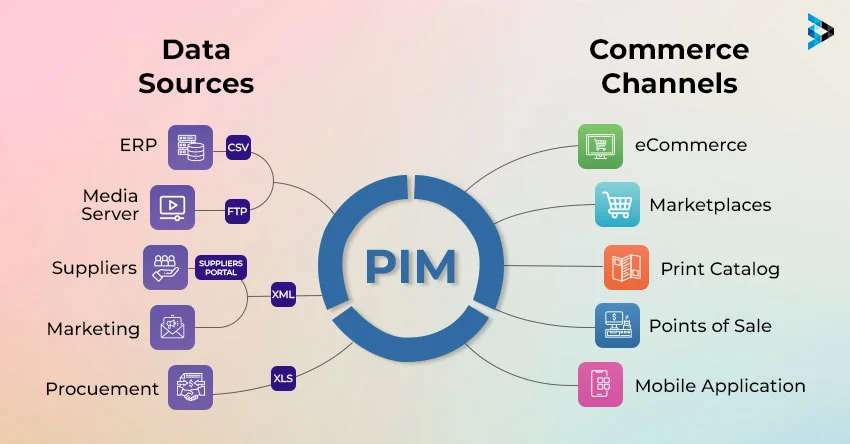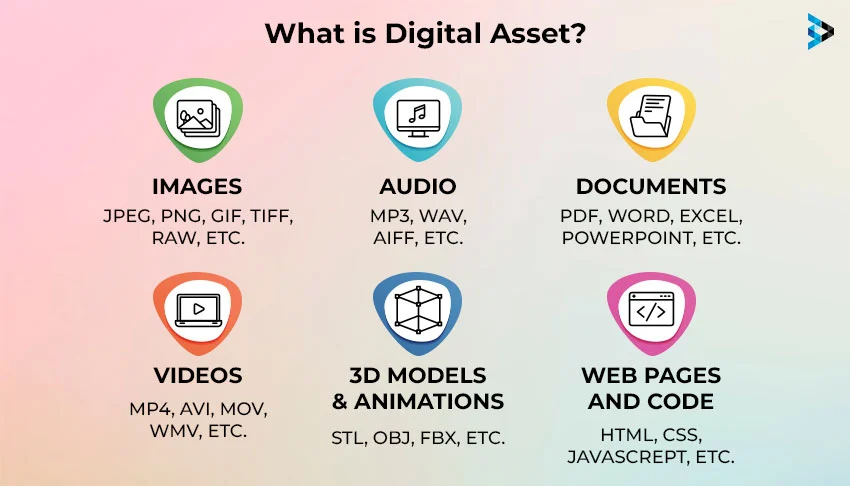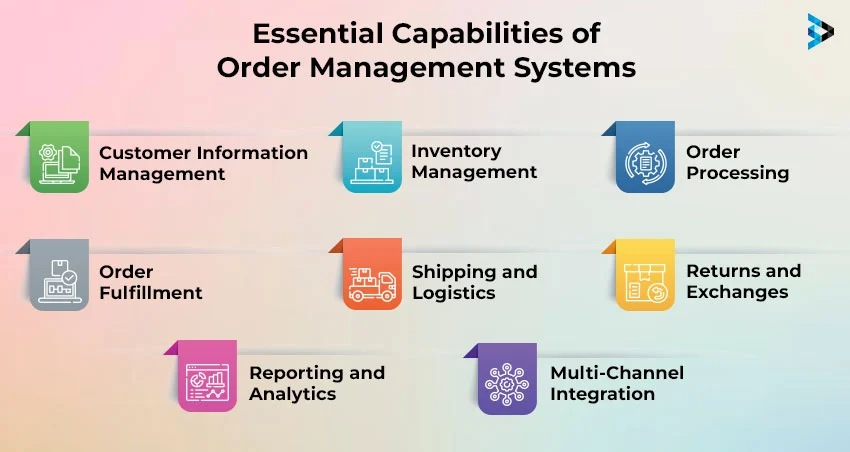Businesses have to be adjustable enough to handle orders and product information to cope with the challenges of the ever-changing e-commerce industry. Product Information Management (PIM) systems, as well as Order Management Systems (OMS) that are being used today, can be limiting and tedious aspects hindering business from attaining its full potential. With its smooth integration of PIM and OMS functionalities, Adobe Commerce is a rich-featured solution that enhances both order management and product information management. In this blog, we shall discuss how Adobe Commerce can transform your business and provide a formidable opposition to conventional PIM and OMS systems.
What is PIM (Product Information Management)?
A tool called PIM (Product Information Management) allows businesses to structure and share their information efficiently when designing captivating user experiences with their teams.
Serving as a central hub, it allows for accessing, enriching, and distributing accurate and up-to-date product information to sales and marketing channels. Users leveraging PIM tools can rectify errors 18 times faster than those who haven't adopted such technology. With Adobe Commerce integration, PIM provides an authorized and audited single access point, enhancing customer experience, business organization, and product data management.
What’s OMS (Order management system)?
An Order Management System (OMS) is a computer tool applied in e-commerce to keep tabs on sales, orders, inventory, and fulfillment. It provides accuracy and efficiency by standardizing the order processing flow from order receipt up to delivery.
Implementing an Order Management System (OMS) offers several key advantages, including effective inventory management, handling returns and exchanges, optimizing fulfillment and delivery processes, and consolidating order information from multiple sales channels. An OMS can reduce costs, save time, and improve customer relations by automating many procedures. Additionally, it helps businesses stay agile and responsive to evolving consumer trends.
Key Features of PIM
Companies can make use of Product Information Management or PIM as a powerful tool for managing and optimizing product data. The following are the features of PIM:
Centralized Data Repository
Systems that facilitate systemization and data storage concerning products are centrally situated in Product Information Management (PIM) databases. All product information is stored here; it is a reference database for storing product information to ensure its integrity and applicability in multiple platforms and media types. Thus, product information management systems facilitate the process of product data upkeep and change management by consolidating product information, which, in turn, reduces the likelihood of errors and discrepancies.
Data Integration
PIM connectors enable data to be easily connected with other corporate systems, such as enterprise resource planning (ERP), e-commerce platforms, content management systems (CMS), and Adobe Commerce Development solutions. This integration ensures that product information is represented reliably and in the same format in all integrated systems, eliminating data incompatibility and format inconsistencies.
Attribute Management
PIM systems help firms to be able to develop new and manage existing product attributes instantly because of their robust attribute management solutions. The collection of families of attributes enables easier management of related items and keeps the organization consistent. It is also true that PIM solutions include capabilities for data validation to ensure the datasets’ quality and non-tampering.
Digital Asset Management (DAM)
PIM and DAM (digital asset management) have similar meanings. Still, in fact, they are different concepts. While PIM is concerned with the product master data, DAM is concerned with assets like images, videos, and documents, although both deal with digital data. When incorporated with each other, the two products in question allow for making data asset management comprehensive, involving the strengths of both to create a stable and efficient system for using data.
Data Quality and Governance
To enhance data integrity, superior data governance concepts are integrated into products to ensure data accuracy across the linked systems. These measures check for the quality, cleanliness, and validity of products in an effort to maintain up-to-date details.
Validation and Cleansing
Since data errors may be costly, a PIM tool thus has functionalities for data validation and data cleaning. These features help sustain accurate data quality since they control and eradicate mistakes, replicates, and variation.
Workflow Management
PIM solutions comprise features related to workflow management to enable companies to define and monitor the processes of distribution, editing, and product approval. This reduces basic errors while enhancing the effectiveness of the Product Information Management System. This characteristic is very beneficial for eCommerce development since it assures the proper and accurate detailing of the products irrespective of the platform or channel.
Catalog Management
PIM solutions help firms to systematically create and maintain product catalogs as it offers them catalog management. These catalogs serve as a reference point for product data, making it easy to share the data, including updating it within the various channels and devices.
Multichannel Publishing
Publication management enables the creation of documents for several channels. Media placement lets companies share information about products on sites and other internet resources, social profiles, and printed media. This also enhances the consumer experience by ensuring that information about products is well conveyed and in harmony with the different consumer touch points.
Multi-language Support
Translation capability is often provided in PIM systems, enabling organizations to manage product information in different languages. This function is quite beneficial for business establishments involved in international business since it assures that information about products provided to the general public is accurate and standardized across various markets and geographical regions.
Key Features of OMS
An order management system or OMS is software that tracks an order’s progress from placement through delivery and beyond. Key things which make OMS an essential tool for any enterprise include:
Order Processing
With the help of an OMS, businesses can consolidate orders originating from online stores, physical stores, and marketplaces and process and track them through the order processing function. One of the possible ways to shorten processing times up to 50% through an OMS implementation. This feature ensures that all orders are entered, checked, and forwarded to the right warehouse or fulfillment center for servicing.
Inventory Management
In order for the firms to be able to order goods when they are out of stock, and likewise avoid situations where they order for goods that they have a lot of in excess, inventory management is essential. The real-time visibility that an OMS offers lets the buyer ensure efficient distribution, replacement, or procurement of the products. Order fulfillment assures a timely and efficient way of dealing with orders, partial shipments, and order deliveries to clients.
Customer Information Management
An OMS is mainly involved in managing customer details such as contact details, order details, and preferences. Depending on this feature, companies may be able to monitor customer engagement, extend unique customer services, and analyze consumption patterns to upgrade marketing strategies and detect poor customer loyalty.
Order Fulfillment
An OMS solution may help businesses assess prices, generate labels, and monitor shipments, although it may integrate with many logistics firms and carriers. This service helps the consumer get real-time estimates of delivery time and consignment tracking while boosting the shipment process.
Shipping and Logistics
Customer service is said to comprise a key component of exchange and returns management. An OMS makes most procedures involving returning products, requesting refunds or swaps, or tracking the status of returned products easier for the shipping and logistics industry.
Returns and Exchanges
A multitude of reporting and analytical functions available within an OMS assist in organizing, managing, and analyzing business operations. KPIs may be monitored, reports produced, and actionable knowledge obtained. Conclusions can be drawn about the use of sales, inventory, customers, and order fulfillment reports to optimize data-driven decisions and processes.
Reporting and Analytics
Several significant reporting and analysis functions can be employed in an OMS to help businesses monitor their KPIs, produce reports, and gain insights into their operations. Reporting and analytics tools involve sales, inventory, customer, and order fulfillment reports that can enable data-driven decision-making and improved processes.
Multi-Channel Integration
An OMS enables businesses to consolidate and manage orders from multiple sales channels like markets, regular outlets, online platforms, and others. It improves customer engagement by providing aggregated data on customer relationships and the history of their orders. It ensures that orders are handled similarly across sales touchpoints.
Difference Between PIM and OMS
The following are the difference between PIM and OMS:
| Aspect | Product Information Management (PIM) | Order Management System (OMS) |
| Primary Function | Manages product data and information | Manages order processing and fulfillment |
| Focus | Centralizes and optimizes product details | Tracks and controls order lifecycle |
| Key Features | Data enrichment, catalog management, syndication | Order tracking, inventory management, customer service |
| User Base | Marketing, product managers, content creators | Sales, customer service, supply chain managers |
| Integration | Integrates with eCommerce platforms, ERP, CRM systems | Integrates with shipping carriers, payment gateways, inventory systems |
| Purpose | Is responsible for the management of information and data on products | Handles the order processing and the overall execution and delivery of service |
| Examples | Akeneo, Salsify | Shopify, Oracle Order Management |
Adobe Commerce As a PIM and OMS Features
Adobe Commerce (previously known as Magento Commerce) revealed high native capabilities that enable it to function as an efficient Order Management System (OMS) and Product Information Management (PIM).
Why Adobe Commerce as a PIM
Adobe Commerce, formerly known as Magento, is a reliable eCommerce platform but lacks complex PIM features. Thus, it is necessary to integrate a PIM system to manage product data efficiently and improve user experiences.
- Simple import/export of product data: Consume products from various sources within a short period and also export products for consumption elsewhere. Open access, where it accepts multiple file formats such as JSON, XML, CSV, etc.
- Simple product attribute management: To ensure that the product data is complete, always develop and sustain exclusive attributes that pertain specifically to the products. However, to make administration a bit easier, grouping these attributes will involve forming an Attribute Set.
- Multiple catalog management: Multiple catalog management means managing many product catalogs for different websites, actual stores, or sales outlets. It is easy to make changes, and therefore, it is possible to switch between different catalogs.
- Support for many languages: Read the markets worldwide and create product material in the various languages spoken. Translate the product name, attribute characteristic, and description.
- Multiple sales channel management: The sales channel allows users to track product information across various points of sale, including social media, online stores, and marketplaces. Product information on different platforms should be consistent.
Why Adobe Commerce as an OMS
In terms of wide customization options, scalability, seamless integration capabilities, and full functionality for enhancing e-commerce operations, Adobe Commerce emerges as an advanced Order Management System (OMS).
- Order management centralized: In any case, customers can use Adobe Commerce as a single platform to manage all the orders. This makes your work easier when it comes to tracking, order fulfillment, and order management, as it provides you with a view of all the orders.
- Multiple-source Inventory Control: Due to its efficient inventory features, one can easily control inventory in multiple locations and stores, warehouses, or fulfillment centers. This way, it is possible to avoid overusing shipping services and time, always trying to get the most out of the stocks and finalizing the orders from the nearest location.
- Easy Integration with Various Marketplaces: Adobe Commerce can be easily integrated with most e-commerce platforms, such as Amazon and eBay. This improves your order management procedures because you can manage orders from multiple places in one place, enhancing efficiency. As a result, the integration of various eCommerce channels allows for easy interaction between buyers and sellers while enabling both sides to meet their separate interests very efficiently.
- Easy Ways to Import and Export Order Data: You may easily export and import order data from/to the platform to help you sync it with the existing business solutions and processes. This involves eradicating manual data entry to ensure seamless and effective communication, which saves time and reduces the chances of errors.
- Adopting Easy Shipping Gateways: Adobe Commerce enables you to integrate with numerous shipping carriers, therefore providing the possibility for smooth integration with your preferred shipping providers. This makes it easier to track the order, produce the shipping labels, and provide estimates of the exact goods to the clients.
- Effective Production of Shipping Labels and Invoices: Thus, the OMS in Adobe Commerce saves time for preparing shipping labels and invoices and ensures proper documentation of each order.
- Refunds and Returns Managed Effectively: AI-Driven eCommerce development provides effective and convenient tools for processing returns and refunds, allowing for the management of the client’s request and maintaining the overall positive experience during shopping.
Real-life Example
A viable solution that can replace classical OMS and PIM systems is Adobe Commerce, formerly known as Magento. Adidas, an international sportswear company, is an example of a real-life company. Adidas made a tremendous improvement in the company’s commerce landscape after they managed to connect Adobe Commerce with PIM and OMS.
With the help of technology, Adidas was in a position to handle its inventory, order, and product catalog for a number of sales channels; its website, marketplaces, and physical stores. The implementation of the system allowed Adidas to extend the consumer satisfaction rate, enhance the operational performance, and give the consumer an extended idea of the brand, making it a success.
Conclusion
In summary, Adobe Commerce offers suitable foundations for companies in search of a comprehensive OMS and PIM system from a single source. Being an Adobe partner, we are ready to help you leverage this platform to its extent in enhancing client experience and business growth. Adobe Commerce will help you control and update your product information, as well as facilitate various processes and order management, thanks to which your company will have a great chance to succeed in the modern world of e-commerce competition.
Read more: How AEM Helps Business to Work Through Author and Publisher Environments
FAQs
What is PIM?
Businesses utilize a system called PIM to organize, administer, and distribute product information through different sales promotions, e-commerce websites, and other sales channels. This maintains accurate and consistent product data which results in satisfied customers while increasing sales.
What does OMS stand for?
OMS enables efficient order-to-cash cycles by handling orders, stock control, goods transportation, and returns. Through communication with various sales channels and warehouses, it also facilitates faster returns and exchanges, automates order processing, and provides real-time inventory details.
What is Adobe Commerce?
Adobe Commerce’s commerce platform is scalable and flexible, enabling companies to develop personalized B2B or B2C experiences. Connected to it, Adobe Experience Cloud offers a comprehensive view of customers and firms. This includes omnichannel personalization, AI-assisted retailing, composable commerce development, etc.
How does Adobe Commerce function as a PIM?
Adobe Commerce serves as a PIM because it provides one consolidated platform for managing product information. In commerce experiences, Adobe Commerce integrates with Adobe Experience Manager to deliver high-impact content. Also available on its platform are upselling, cross-selling, and product recommendations, which depend on reliable and coherent product data.
What are the main advantages of using Adobe Commerce as a PIM?
Among the key benefits of using Adobe Commerce as a PIM are enhanced customer satisfaction through consistent product information, improved sales efficiency through targeted product recommendations, and automated handling of product data that enhances productivity.
What are the key features of Adobe Commerce as an OMS solution?
Adobe Commerce offers inventory synchronization, order processing, refunds and exchanges, shipping and fulfillment services, and returns. Its use can help reduce operating costs, improve customer relations, and shorten the order-to-cash process cycle.
Can Adobe Commerce handle high order volumes?
By ensuring quick, flawless experiences during busy events by providing sophisticated features like cloud-native solutions, auto-scaling, performance monitoring tools, etc. This software works hand in hand with experts from Adobe managed services to help optimize its process due to its need for large volumes of orders.
Related Articles
Digital Transformation
Hyper-Personalized Banking: Driving Customer Loyalty and Engagement with AI-Powered Adobe Experiences
Digital Transformation
Leveraging 3rd Party LLMs: A Guide to Commercial AI Platforms
Digital Transformation
AI-Driven Security: Protecting Your eCommerce App and Customer Data in an Evolving Threat Landscape








